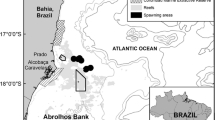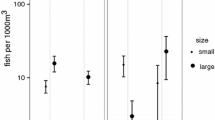Abstract
Females of some polygynous fish species display female nuptial signals (FNSs), advertising spawning readiness to potential mates. Halichoeres margaritaceus, a polygynous coral reef fish, reportedly display red belly color and a unique bobbing behavior as FNSs advertising spawning readiness. In this study, I examined whether FNSs were observed in an H. margaritaceus population in Australia. Females in this study displayed red belly color as an FNS, although at a lower intensity than that reported in a Japanese population. Contrary to observations made in the Japanese population, bobbing behavior performed by females in this study showed no temporal trend as spawning approached, indicating bobbing behavior did not function as an FNS in the Australian population. The role of local selective pressures on FNS intensity and lifetime reproductive benefits H. margaritaceus may potentially gain in utilizing FNSs are briefly discussed.




Similar content being viewed by others
References
Amundsen T, Forsgren E (2001) Male mate choice selects for female coloration in a fish. Proc Natl Acad Sci U S A 98:13155–13160
Andersson M (1994) Sexual Selection. Princeton University Press, New Jersey
Baird TA (1988) Abdominal windows in straight-tailed razorfish, Xyrichtys martinicensis: an unusual female sex character in a polygynous fish. Copeia 1988:496–499
Baldauf SA, Bakker TCM, Kullmann H, Thünken T (2011) Female nuptial coloration and its adaptive significance in a mutual mate choice system. Behav Ecol 22:478–485
Clark E, Petzold R (1998) Spawning behavior of the collared knifefish, Cymolutes torquatus. Environ Biol Fishes 53:459–464
Cole GL (2013) Lost in Translation: adaptation of Mating Signals in Changing Environments. Springer Sci Rev 1:25–40
Domb LG, Pagel M (2001) Sexual swellings advertise female quality in wild baboons. Nature 410:204–206
Endler JA (1992) Signals, signal conditions, and the direction of evolution. Am Nat 139:S125–S153
Fujii R (2000) The regulation of motile activity in fish chromatophores. Pigment Cell Res 13:300–319
Fuller R, Berglund A (1996) Behavioral responses of a sex-role reversed pipefish to a gradient of perceived predation risk. Behav Ecol 7:69–75
Hamilton WJ, Poulin R (1999) Female preference and male nuptial colouration in the freshwater fish Gobiomorphus breviceps: geographic variation among populations. Can J Zool 77:463–469
Kokko H, Johnstone RA (2002) Why is mutual mate choice not the norm? Operational sex ratios, sex roles and the evolution of sexually dimorphic and monomorphic signaling. Philos Trans R Soc Lond B Biol Sci 357:319–330
Kuwamura T, Karino K, Nakashima Y (2000) Male morphological characteristics and mating success in a protogynous coral reef fish, Halichoeres melanurus. J Ethol 18:17–23
Landis JR, Koch GG (1977) The measurement of observer agreement for categorical data. Biometrics 33:159–174
LaPlante LH (2015) Female belly colour and bobbing behaviour advertise sexual receptivity in a pelagic-spawning coral reef fish. Behaviour 152:705–725
Malavasi S, Valerio C, Torricelli P (2009) Courtship sounds and associated behaviours in the Canestrini’s goby Pomatoschistus canestrinii. J Fish Biol 75:1883–1887
Meyer KA (1977) Reproductive behavior and patterns of sexuality in the Japanese Labrid fish Thalassoma cupido. Jpn J Ichthyol 24:101–112
Munday PL, Buston PM, Warner RR (2006) Diversity and flexibility of sex-change strategies in animals. Trends Ecol Evol 21:89–95
Munday PL, Ryen CA, McCormick MI, Walker SPW (2009) Growth acceleration, behaviour and otolith check marks associated with sex change in the wrasse Halichoeres miniatus. Coral Reefs 28:623–634
Muñoz RC, Warner RR (2003) A new version of the size-advantage hypothesis for sex change: Incorporating sperm competition and size-fecundity skew. Am Nat 161:749–761
Nemtzov SC (1985) Social control of sex change in the Red Sea razorfish Xyrichtys pentadactylus (Teleostei, Labridae). Environ Biol Fishes 14:199–211
Olla BL, Samet C (1977) Courtship and spawning behavior of the tautog, Tautoga onitis (Pisces: Labridae), under laboratory conditions. Fish Bull (Seattle) 75:585–599
Randall JE, Allen GR, Steene RC. 1996. Fishes of the Great Barrier Reef and Coral Sea. Crawford House Publishing Pty Ltd, Bathurst
Reimchen TE. 1989. Loss of nuptial color in threespine sticklebacks. Evolution 43:450-460
Robertson DR. 1981. The social mating systems of two labrid fishes, Halichoeres maculipinna and H. garnoti, off the Caribbean Coast of Panama. Mar Biol 64:327–340
Robertson DR, Hoffman SG (1977) The roles of female mate choice and predation in the mating systems of some tropical labroid fishes. Z Tierpsychol 45:298–320
Rowland WJ, Grindle N, MacLaren RD, Granquist R (2002) Male preference for a subtle posture cue that signals spawning readiness in female sticklebacks. Anim Behav 63:743–748
Sakai Y, Karino K, Nakashima Y, Kuwamura T (2002) Status-dependent behavioural sex change in a polygynous coral-reef fish, Halichoeres melanurus. J Ethol 20:101–105
Shibuno T, Chiba I, Gushima K, Kakudal S, Hashimotol H (1993) Reproductive Behavior of the Wrasse, Halichoeres marginatus, at Kuchierabu-jima. Jpn J Ichthyol 40:351–359
Sköld HN, Aspengren S, Wallin M (2013) Rapid color change in fish and amphibians–function, regulation, and emerging applications. Pigment Cell Melanoma Res 26:29–38
Svensson PA, Pélabon C, Blount JD, Forsgren E, Bjerkeng B, Amundsen T (2009) Temporal variability in a multicomponent trait: nuptial coloration of female two-spotted gobies. Behav Ecol 20:346–353
Victor BC (1987) The mating system of the Caribbean rosy razorfish, Xyrichtys martinicensis. Bull Mar Sci 40:152–160
Walker SP, Ryen C (2007) Opportunistic hybridization between two congeneric tropical reef fish. Coral Reefs 26:539–539
Warner RR (1975) The Adaptive Significance of Sequential Hermaphroditism in Animals. The American Naturalist 109:61–82
Warner RR (1988) Sex change and the size-advantage model. Trends Ecol Evol 3:133–136
Warner RR (1991) The use of phenotypic plasticity in coral reef fishes as tests of theory in evolutionary ecology. In: Sale PF (ed) The ecology of fishes on coral reefs San. Academic Press, Inc, Diego, p 387–398
Weiss SL (2002) Reproductive signals of female lizards: pattern of trait expression and male response. Ethology 108:793–813
Acknowledgements
This research was supported by grants and fellowships from the 2004 East Asia and Pacific Summer Institutes Program (Australian Academy of Sciences/National Science Foundation OISE-0413589), Explorer’s Club (Exploration Fund), National Undersea Research Center, and the John Rankin, Jr., Ralph Wetzel and Walter R. Whitworth Endowments made jointly to the Department of Ecology and Evolutionary Biology at the University of Connecticut and The Connecticut State Museum of Natural History. Underwater video and editing equipment were generously provided by the National Undersea Research Center. I am extremely grateful to K. Barber for her extensive field assistance, and A. Hoggett, L. Vail, and the staff at Lizard Island Research Station for their expertise and support. Research was conducted under the Great Barrier Reef Marine Park Authority permit number G04/12209.1 and Queensland Fisheries Service permit number PRM04709K. All procedures performed were in accordance with the ethical standards and guidelines outlined in the Animal research protocol #V2701501 approved by the Institutional Animal Care and Use Committees at University of Connecticut. I am particularly grateful to P. Auster, E. Schultz, and K. Wells for their support and advice, and critical comments made on early versions of this manuscript. I also thank the two anonymous reviewers whose comments helped improve the final draft of this manuscript.
Author information
Authors and Affiliations
Corresponding author
About this article
Cite this article
LaPlante, L.H. Female nuptial signal advertises spawning readiness in a population of Halichoeres margaritaceus on the Great Barrier Reef, Australia. Ichthyol Res 64, 331–338 (2017). https://doi.org/10.1007/s10228-016-0571-2
Received:
Revised:
Accepted:
Published:
Issue Date:
DOI: https://doi.org/10.1007/s10228-016-0571-2




